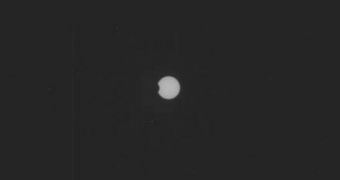The Mars Science Laboratory (MSL) rover Curiosity snapped an incredible picture from the surface of the Red Planet on Thursday, September 13, when it saw the diminutive moon Phobos partially eclipsing the Sun. The momentous event takes place just five weeks after touching down at Bradbury Landing.
The robot is currently in the process of having all of its instruments commissioned and tested, mission controllers at the NASA Jet Propulsion Laboratory (JPL) in Pasadena, California, explain.
They say that the Mast Camera (Mastcam) instrument was used to snap this image, which shows just how different the Red Planet is from Earth. Whereas our large moon is capable of occupying the entire disk of the Sun, the same cannot be said for Phobos.
With a diameter of just 22 kilometers (14 miles), a far cry from the Moon's 3,476 kilometers (2,160 miles), the Martian moon is unable to produce more than a small dip in solar brightness, as seen from the surface of our neighboring world.
On the other hand, if Phobos were to orbit Mars at the same distance the Moon does around Earth, then it's highly unlikely that it would produce much of a discernible effect at all. In the case of Deimos, the Red Planet's other moon, solar eclipses are so dim they cannot be noticed from the ground.
One of the reasons why such large differences exist between the two planets is that the Martian moons are most likely asteroids that were unfortunate enough to be captured by the planet's gravitational pull.
Another theory suggests that they formed from material that was ejected in planetary orbit following a cataclysmic asteroid impact, billions of years ago. Establishing the origins of these bodies is difficult without actually sending a sample-return mission there.
Thus far, all such efforts have failed, most notably last year. In late 2011, the Russian Federal Space Agency (RosCosmos) launched its Phobos-Grunt mission, but the spacecraft failed shortly upon reaching orbit, and eventually fell back to Earth, Space reports.
Back on Mars, Curiosity is being prepared for another round of similar observations. “Actually, there are I think three opportunities in the next month or so where we'll image those transits. They're neat opportunities to see a unique scientific observation,” said Curiosity's mission manager, Jennifer Trosper.
Over the weekend, the rover moved forward by about 86 meters (282 feet) in a new drive. This means that it traveled in excess of 227 meters (745 feet) since landing on Mars, on August 6.

 14 DAY TRIAL //
14 DAY TRIAL //